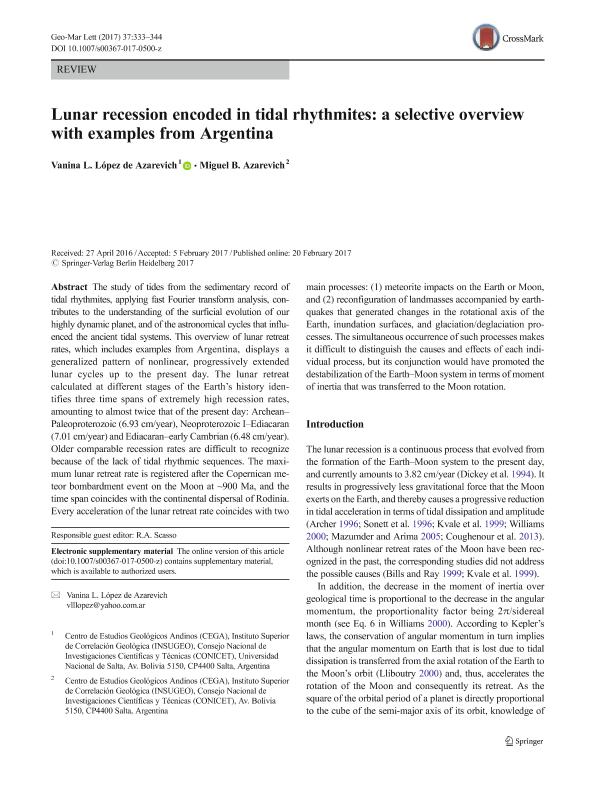Mostrar el registro sencillo del ítem
dc.contributor.author
López, Vanina Lucrecia

dc.contributor.author
Azarevich, Miguel Basilio

dc.date.available
2018-12-20T18:17:21Z
dc.date.issued
2017-08
dc.identifier.citation
López, Vanina Lucrecia; Azarevich, Miguel Basilio; Lunar recession encoded in tidal rhythmites: a selective overview with examples from Argentina; Springer; Geo-marine Letters; 37; 4; 8-2017; 333-344
dc.identifier.issn
0276-0460
dc.identifier.uri
http://hdl.handle.net/11336/66852
dc.description.abstract
The study of tides from the sedimentary record of tidal rhythmites, applying fast Fourier transform analysis, contributes to the understanding of the surficial evolution of our highly dynamic planet, and of the astronomical cycles that influenced the ancient tidal systems. This overview of lunar retreat rates, which includes examples from Argentina, displays a generalized pattern of nonlinear, progressively extended lunar cycles up to the present day. The lunar retreat calculated at different stages of the Earth’s history identifies three time spans of extremely high recession rates, amounting to almost twice that of the present day: Archean–Paleoproterozoic (6.93 cm/year), Neoproterozoic I–Ediacaran (7.01 cm/year) and Ediacaran–early Cambrian (6.48 cm/year). Older comparable recession rates are difficult to recognize because of the lack of tidal rhythmic sequences. The maximum lunar retreat rate is registered after the Copernican meteor bombardment event on the Moon at ~900 Ma, and the time span coincides with the continental dispersal of Rodinia. Every acceleration of the lunar retreat rate coincides with two main processes: (1) meteorite impacts on the Earth or Moon, and (2) reconfiguration of landmasses accompanied by earthquakes that generated changes in the rotational axis of the Earth, inundation surfaces, and glaciation/deglaciation processes. The simultaneous occurrence of such processes makes it difficult to distinguish the causes and effects of each individual process, but its conjunction would have promoted the destabilization of the Earth–Moon system in terms of moment of inertia that was transferred to the Moon rotation.
dc.format
application/pdf
dc.language.iso
eng
dc.publisher
Springer

dc.rights
info:eu-repo/semantics/openAccess
dc.rights.uri
https://creativecommons.org/licenses/by-nc-sa/2.5/ar/
dc.subject
Lunar
dc.subject
Puncovisacana
dc.subject
Tidalites
dc.subject
Argentina
dc.subject.classification
Meteorología y Ciencias Atmosféricas

dc.subject.classification
Ciencias de la Tierra y relacionadas con el Medio Ambiente

dc.subject.classification
CIENCIAS NATURALES Y EXACTAS

dc.title
Lunar recession encoded in tidal rhythmites: a selective overview with examples from Argentina
dc.type
info:eu-repo/semantics/article
dc.type
info:ar-repo/semantics/artículo
dc.type
info:eu-repo/semantics/publishedVersion
dc.date.updated
2018-12-19T14:41:25Z
dc.journal.volume
37
dc.journal.number
4
dc.journal.pagination
333-344
dc.journal.pais
Alemania

dc.journal.ciudad
Berlin
dc.description.fil
Fil: López, Vanina Lucrecia. Consejo Nacional de Investigaciones Científicas y Técnicas. Centro Científico Tecnológico Tucumán. Instituto Superior de Correlación Geológica. Grupo Vinculado al INSUGEO- Centro de Estudios Geologicos Andinos; Argentina
dc.description.fil
Fil: Azarevich, Miguel Basilio. Consejo Nacional de Investigaciones Científicas y Técnicas. Centro Científico Tecnológico Tucumán. Instituto Superior de Correlación Geológica. Grupo Vinculado al INSUGEO- Centro de Estudios Geologicos Andinos; Argentina
dc.journal.title
Geo-marine Letters

dc.relation.alternativeid
info:eu-repo/semantics/altIdentifier/doi/https://dx.doi.org/10.1007/s00367-017-0500-z
dc.relation.alternativeid
info:eu-repo/semantics/altIdentifier/url/https://link.springer.com/article/10.1007/s00367-017-0500-z
Archivos asociados
